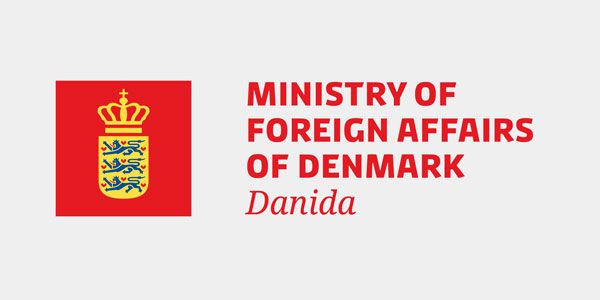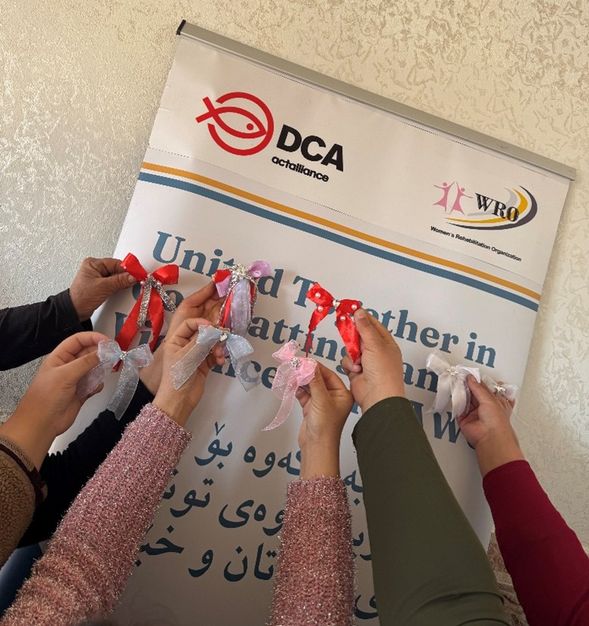At AI-Amal Center in Jadaa Camp, DanChurchAid and its partner, the Women’s Rehabilitation Organization (WRO), are supporting displaced women and girls through creative activities that foster healing and resilience.
With the support of DCA and WRO, painting sessions have become a safe space where participants process trauma, rebuild community bonds, and begin to reclaim a sense of self. For many, holding a paintbrush was the first step toward restoring lost confidence and reconnecting with others.
In this news, we refer to the women using initials of their names to protect their identities while honoring their voices and experiences.
Healing through art
M.S., a 37-year-old mother of three, carries deep scars from her journey. After discovering her husband’s involvement with an armed group, she faced violence, divorce, and fear for her children’s safety. Her escape to Syria’s Al-Hol camp was fraught with hardship, and even after returning to Iraq, the emotional wounds remained.
“After returning to Iraq and moving to Jadaa camp, I felt some stability, but anxiety and fear never left me,” M.S. said. “When I joined painting activity at WRO center, I began to feel a gradual change. Art became a safe space for me to express myself, and it helped me overcome my negative emotions. “
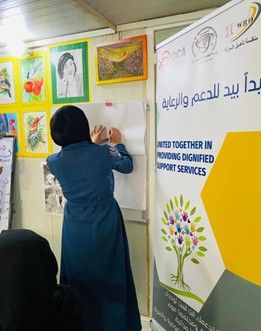
M.S. shared how creating art became part of her healing process.
With each painting I created, I felt like I was reclaiming a part of my life and building a new, safer world for my children and me.”
For M.F., a 19-year-old from Nineveh Province, art became a lifeline during overwhelming loneliness and anxiety. Separated from her family, she found herself withdrawing from everyone.
“I couldn’t stop thinking about my family left behind in Al-Hol,” she shared.
“When I first picked up the brush, my hands were shaking. But as I painted, all those repressed emotions started spilling out onto the paper. After each session, I felt lighter, as if a heavy burden had been lifted.”
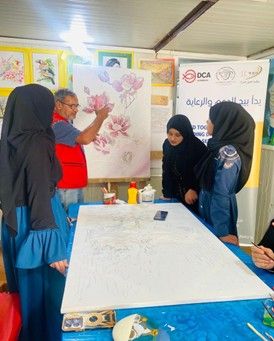
As M.F. grew more confident, her paintings became a reflection of her healing.
Painting became a way for me to express myself and release feelings of anxiety and negative energy. I realized that art is not just an activity, but a tool that helps me understand myself and deal with my emotions in a positive way.”M.F. described what the artwork meant for her.
Rediscovering passion and connection
For M.A., a 21-year-old mother of four from Anbar Province, the painting sessions were a rare opportunity to reconnect with her identity beyond caregiving. Married young, M.A. was overwhelmed with responsibility and rarely left her tent.
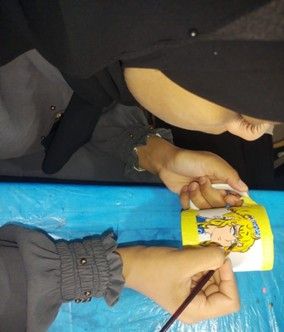
“At first, I sat in front of the paper and colors, feeling scared and lost,” she admitted. “But the kindness and patience of the staff made me feel safe. I realized that I didn’t need to be an expert. Painting brought back feelings of joy and freedom I hadn’t felt in years.”
The activities also fostered new friendships. “Through this activity, I met other women, and we talked about our experiences and fears. I felt like I wasn’t alone and that there were women who shared the same challenges with me.” M.A. said.
“I gained more confidence in myself and began to feel that I was capable of teaching my children new things filled with love and beauty.”M.A. described how creating art helped her regain confidence.
Grieving, remembering, and finding hope
For younger participants like H.A., 16, the sessions helped process deep personal loss.
After her grandmother’s death, H.A. isolated herself and struggled to interact with others.
“My grandmother was the one who understood me and gave me a sense of security,” H.A. said softly. “After she left, I started feeling lonely and preferred isolation. But over time, I began to notice that I found comfort every time I held the brush. I would paint and feel as if I was releasing my emotions onto the paper, as if the colors were telling what was inside me without needing words.”
K.W., also 16, longed for her peaceful childhood on a small farm in Kirkuk.
“When I painted landscapes and farms, I felt at ease,” K.W. recalled. “It was like traveling back to a happier time. Painting helped me reconnect with the part of me that still loved life.”
A.R., a 12-year-old girl from Salah al-Din, found a sense of belonging through the activity.
Family tensions and loss during displacement left her feeling invisible at home.
“I didn’t know that painting could be this fun,” A.R. admitted. “The activity was an opportunity to meet new girls, and we started gathering together to paint. One time, I suggested to my friends that we paint in my tent, and it was a beautiful feeling that made me realize that I could offer something and that I had a place among them.”
Her participation also improved her family relationships.
“Even my family started noticing that I had become calmer and began helping more around the house,” A.R. said proudly. “The friendship I built with the girls during this activity, along with the fun of painting, made me feel that life could be better than I thought.”
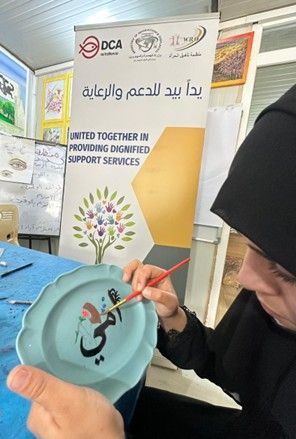
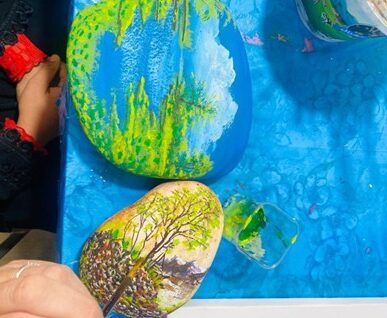
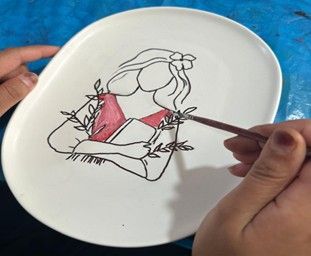
A pathway to hope
For all these women and girls, painting became more than a simple activity. It has been an important way to rebuild confidence, express hidden emotions, and create a community of mutual support.
Through small moments – choosing colors, telling stories, encouraging one another – they began to reclaim parts of their lives lost to conflict and hardship.
Art provided a window to hope, reminding them that even in the harshest conditions, beauty, creativity, and resilience can still thrive.
About the project
Project title: Combatting Violence Against Women and Girls
This project ensures that at-risk communities in Duhok, Erbil, and Ninewa continue to access critical protection services, including support for survivors of violence against women and girls (VAWG), mental health and psychosocial support (MHPSS), and legal aid.
Implemented by the Women’s Rehabilitation Organization (WRO) with support from DCA, the project aims to strengthen DCA’s capacity to sustain humanitarian interventions amid growing instability. It focuses on safeguaring essential services for vulnerable groups, particularly women and girls, and protects them from risks such as survival sex, trafficking, and severe psychological distress.
This project is supported by Danida.
